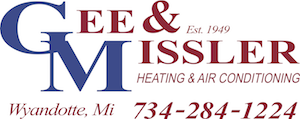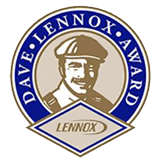
Ceiling fans are one of the most overlooked ways to enhance comfort and lower energy costs. By boosting air circulation and assisting your HVAC system, ceiling fans and energy efficiency are truly a perfect combination. They offer a practical, cost-saving way to stay cool while lessening strain on your AC—helping you avoid unnecessary air conditioning repair.
In this blog, the experts at Gee & Missler Heating & Air Conditioning break down how ceiling fans can keep you cool while saving you money thanks to increased HVAC efficiency. We'll also offer some HVAC efficiency tips that take advantage of ceiling fans.
Comfort vs. Temperature: Getting Comfortable with the Wind-Chill Effect Indoors
Ceiling fans don’t actually change the room’s temperature—they make you feel cooler by blowing air across your skin. This is called the wind-chill effect, and it can make a room feel up to 4 degrees cooler without lowering the thermostat. That means you remain cool and enjoy the benefits of indoor air circulation from your ceiling fan while minimizing air conditioner use—helping reduce your electric bill in summer.
The Best of Both: Why You Should Use Fans and Air Conditioning Together
There are several advantages to using ceiling fans and air conditioning together, especially during the warmer months. By combining both, you maximize HVAC efficiency and maintain a comfortable indoor temperature with less work from your cooling system.
Benefits of using ceiling fans and AC together:
- Ceiling fans help lower HVAC load by spreading cool air more evenly around a room. Decreasing HVAC stress is important, because it can help you avoid a breakdown that could result in premature AC or furnace installation.
- Using ceiling fans enhances comfort by getting rid of warm pockets and improving air movement.
- Combining ceiling fans and AC can lower your utility usage. If you have a home automation system, you can even fine-tune your smart thermostat settings to set the temperature higher while your ceiling fan is running.
Clockwise vs. Counterclockwise Ceiling Fan Rotation: Which Direction Should a Fan Spin?
To maximize the benefits of your ceiling fans year-round, it’s important to ensure blades are rotating in the proper direction for the season. The direction influences how air flows, which can either make you feel cooler or push warm air downward so you feel warmer.
When to spin ceiling fans counterclockwise
When it's hot outside, ceiling fans should turn counterclockwise at a quick speed. This creates a breeze that pushes cool air downward, amplifying the wind-chill effect and creating a cooler sensation.
When it's best to spin ceiling fans clockwise
In the winter, set your fan to spin clockwise on a gentle setting. This lifts cooler air and draws warm air downward from the ceiling, so you feel warmer without changing your thermostat.
What Type of Ceiling Fan Is Best
Picking the best ceiling fan depends on a few important details, including blade design, airflow rating and room dimensions. First, look for fans that offer a good balance of ECFM airflow and blade pitch to ensure efficient air movement in your space:
- ECFM is how much air a fan moves—the cubic feet per minute, or CFM—per watt of electricity it uses. Fans with higher ECFM are more energy efficient.
- Blade pitch refers to the incline of the blades. A sharper blade pitch moves more air than a shallower pitch but can also put extra load on the motor.
Also, consider room size when sizing a ceiling fan—a fan that’s too small won’t move as much air as you'd like, while one that’s too large may be too strong for the space.
Increase Your HVAC Efficiency With the Team from Gee & Missler Heating & Air Conditioning
At Gee & Missler Heating & Air Conditioning, our HVAC experts can help you stay comfortable while minimizing wear on your heating and cooling systems. From efficient ceiling fan strategies and air conditioning installation to smart thermostats and furnace repair, we offer comprehensive services that work with your budget. Schedule your appointment by calling 734-284-1224 today.


